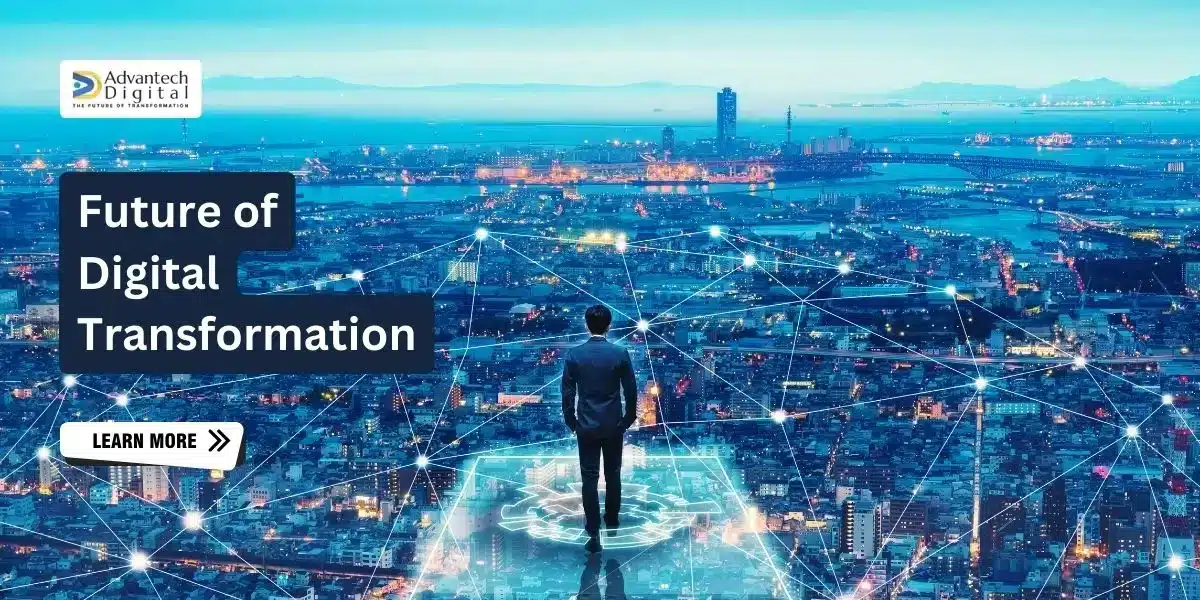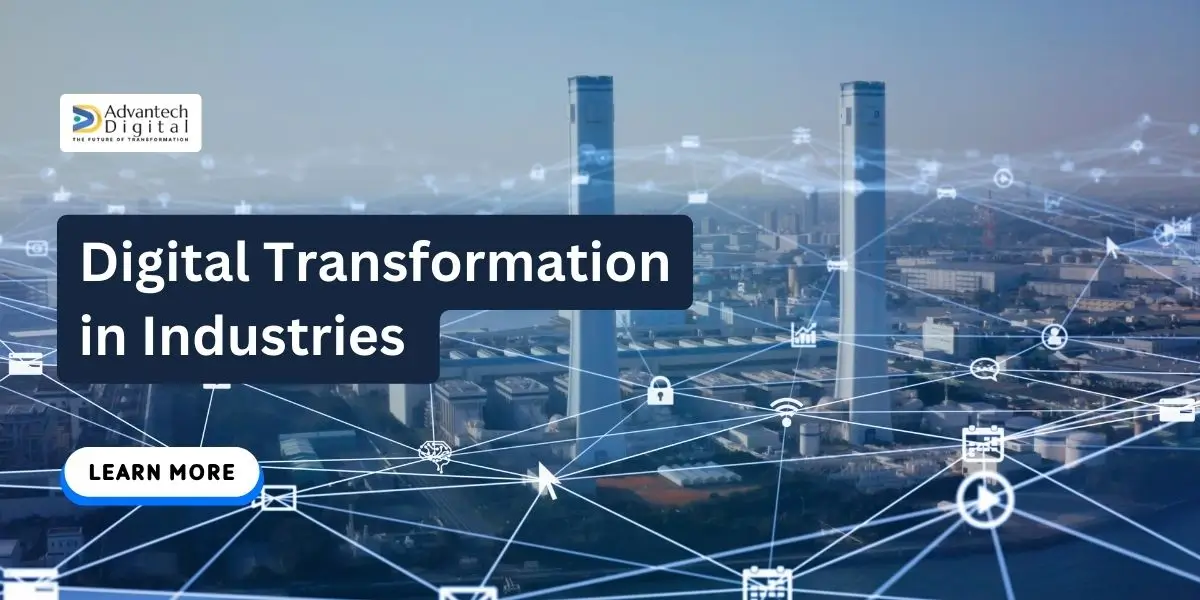The digital revolution is set to redefine industries by 2030. Technological advancements are transforming our lives, work, and interactions. The global future of digital transformation market could reach $4.6 trillion USD by 2030. This growth stems from disruptive technologies and increased adoption of digital solutions.
Advantech Digital leads this digital evolution, guiding businesses through the complex digital landscape. Our innovative solutions help organizations stay ahead and seize digital opportunities. We utilize AI, cloud computing, IoT, and 5G networks to boost business operations.
Understanding key digital transformation trends is vital for future success. AI-powered chatbots, virtual assistants, and IoT devices are revolutionizing industries. These trends create new growth avenues across sectors.
The healthcare sector’s projected CAGR of 28.6% showcases this transformation. Digital technologies are improving patient care and streamlining healthcare delivery. This integration is driving significant growth in the industry.
Key Takeaways
- The global digital transformation market is projected to reach $4.6 trillion USD by 2030, with a CAGR of 26.7% from 2023 to 2030.
- Emerging technologies such as AI, cloud computing, IoT, and 5G networks will drive digital transformation across industries.
- The healthcare sector is expected to have a CAGR of 28.6%, driven by the integration of digital technologies.
- Advantech Digital plays a key role in helping businesses navigate the digital landscape and leverage innovative solutions.
- Understanding and adapting to digital transformation trends is crucial for businesses to stay competitive and drive growth in the digital era.
The Rapid Evolution of Digital Transformation
Digital transformation has been a wild ride for businesses. Early adopters faced challenges integrating new solutions into their operations. A study shows 54% of business owners struggle to meet digital transformation goals. This is due to complexities in incorporating innovative technologies alongside legacy systems.
Gartner emphasizes that groundbreaking technology must rely on Systems of Record (SOR) to be effective. Systems of Collaboration facilitate knowledge flow between employees and departments. Systems of Engagement compile and digest data rapidly, providing real-time business insights.
Success lies in unified digitization, combining systems of productivity and outcomes. This leads to enhanced customer experience technology and improved revenue. Companies like Jira, Trello, and Microsoft 365 enable teams to link workflows and scale productivity across organizations.
A retail giant’s digital platform showcases the impact of digital transformation on financial performance. In 2016, it contributed 20% of overall revenue. By 2024, it became the backbone of the retailer’s success, driving growth even in physical stores.
Customer profiles have evolved from singular personas to diverse demographics, ethnicities, and cultural backgrounds. Businesses adapt strategies to cater to individual needs and preferences. AI and data analytics enable hyper-personalized customer journeys, enhancing interactions and satisfaction.
Predictive analytics supports proactive customer engagement, building trust by addressing issues before they arise. The future focus includes leveraging AI to understand customer motivations and emotional triggers. This deepens connections and ensures retention in a competitive market landscape.
Businesses must balance personalized experiences with data privacy and security concerns. Predictive algorithms are essential for sustaining customer loyalty and compliance with evolving regulations. The digital transformation journey continues to evolve, driving real-time consumer engagement.
Cloud Computing: The Backbone of Digital Transformation
Cloud computing revolutionizes digital transformation, offering scalable, flexible, and secure solutions. Businesses can now access innovative technologies without hefty infrastructure investments. This shift unlocks growth opportunities and fosters innovation across industries.
Cloud migration significantly reduces capital expenses on hardware, software, and maintenance. The pay-as-you-go model optimizes IT spending and improves resource utilization. Startups and small enterprises benefit greatly, accessing cutting-edge tech without breaking the bank.
Scalable and Flexible Cloud Solutions
Scalability is cloud computing’s standout feature. It allows businesses to adapt quickly to changing demands. Organizations can ensure optimal performance by scaling resources up or down as needed.
Cloud solutions offer unparalleled flexibility. Companies can swiftly respond to market dynamics and customer needs. This agility is crucial in today’s fast-paced business environment.
Major providers like AWS, Microsoft Azure, and Google Cloud offer diverse scalable solutions. These range from virtual machines to serverless computing. Such options empower organizations to build, deploy, and manage applications efficiently.
Cloud Security and Data Protection
As digital transformation progresses, data security becomes paramount. Cloud providers prioritize robust security measures and encryption protocols. They invest heavily in cutting-edge security tech and compliance frameworks.
| Cloud Provider | Security Features |
|---|---|
| Amazon Web Services (AWS) | Identity and Access Management (IAM), encryption, firewalls, and intrusion detection |
| Microsoft Azure | Azure Active Directory, Azure Security Center, and Azure Key Vault |
| Google Cloud | Identity and Access Management (IAM), encryption, and Cloud Security Command Center |
Secure cloud storage allows businesses to focus on core competencies. They can trust data management to industry experts. This approach enhances security and enables seamless collaboration across teams and locations.
The COVID-19 pandemic has accelerated the adoption of cloud computing, as businesses rapidly shifted to remote work and digital operations. Cloud-based collaboration tools and secure data storage solutions have become essential for maintaining business continuity and resilience in the face of disruption.
The future of digital transformation is intricately tied to cloud computing’s evolution. Scalable cloud solutions and robust data security unlock new growth opportunities. These advancements drive innovation and competitive advantage in the digital landscape.
AI and Machine Learning: Driving Intelligent Automation
AI-powered automation and machine learning are revolutionizing industries. They optimize complex operations and boost efficiency beyond human capabilities. These technologies redefine core paradigms and transform decision-making frameworks.
Accenture reports that 97% of executives believe generative AI will transform their company. However, 56% cite data readiness as the top adoption challenge. Despite this, AI and ML reshape organizational functionality and streamline workflows.
AI-Powered Chatbots and Virtual Assistants
AI chatbots and virtual assistants revolutionize customer experiences with personalized interactions. These systems use machine learning insights to improve responses. As a result, customer satisfaction and loyalty increase significantly.
Predictive Analytics and Data-Driven Decision Making
AI and ML fuel predictive analytics, enabling data-driven decisions. These technologies analyze vast data sets to identify patterns and forecast trends. They provide actionable insights for businesses to stay competitive.
IDC predicts that by 2025, 90% of new enterprise applications will integrate AI. This empowers businesses to outpace competitors by 80% in implementing new features.
“AI and ML are not just about automating tasks; they are about augmenting human capabilities and unlocking new possibilities.” – Industry Expert
AI and ML impact various sectors:
- In manufacturing, AI-driven robotic systems optimize production processes.
- The financial sector leverages ML algorithms to enhance predictive analytics.
- E-commerce platforms utilize AI-powered recommendation systems to create personalized customer experiences.
AI and ML continue to evolve, offering limitless potential in digital transformation. Organizations embracing these technologies gain a competitive edge. They drive innovation and deliver exceptional value to their customers.
The Internet of Things (IoT): Connected Devices Everywhere
The Internet of Things (IoT) is transforming our interaction with technology. It connects billions of devices worldwide, enabling seamless communication and data exchange. IoT plays a crucial role across industries, from manufacturing to healthcare and smart cities.
The global IoT network boasts 15.9 billion devices. Consumer spending on smart home products is expected to hit $88 billion by 2025. This growth is fueled by 5G technology, projected to support 1.9 billion subscriptions by 2024.
IoT devices are gaining popularity for their automation capabilities. They reduce labor costs and boost operational efficiency. These smart devices have processors and sensors that collect and process environmental data.
By analyzing data locally before cloud transmission, IoT devices optimize performance. They also reduce bandwidth consumption, making them more efficient and cost-effective.
“The Internet of Things has the potential to change the world, just as the internet did. Maybe even more so.” – Kevin Ashton, co-founder of the Auto-ID Center at MIT
The potential applications of IoT are vast, spanning across various sectors:
| Industry | IoT Application |
|---|---|
| Agriculture | Automated farming techniques |
| Construction | Structural monitoring for safety |
| Home Automation | Remote system control |
| Smart Cities | Energy optimization |
| Healthcare | Remote patient tracking |
| Retail | Inventory and customer analysis |
| Transportation | Route optimization |
| Wearable Devices | Data collection and public safety |
| Energy Management | Smart grids and energy optimization |
The IoT market is projected to reach $500 billion by 2023. However, this growth brings cybersecurity challenges. Data breaches, bug exploits, and software complexity are key threats to IoT devices.
Prioritizing security and investing in robust measures is crucial. This approach ensures we reap IoT benefits while minimizing risks.
IoT represents a fundamental shift in our world interaction. As connected devices and smart technologies evolve, we’ll see increased integration of physical and digital realms. This integration will drive innovation and progress across all aspects of our lives.
5G Networks: Enabling Seamless Connectivity
5G networks are revolutionizing our connection with technology. With lightning-fast speeds and ultra-low latency, 5G ushers in seamless connectivity. This tech unlocks possibilities, empowering businesses to streamline operations and enhance collaboration.
5G offers data speeds up to 100 times faster than 4G. This leap enables businesses to process information with unprecedented efficiency. A McKinsey study projects 5G innovations could boost global manufacturing GDP by $400-650 billion by 2030.
The global 5G services market, valued at $83.24 billion in 2021, is expected to grow rapidly. Projections show a 23% CAGR, reaching $188 billion by 2025.
Faster Data Transfer and Lower Latency
5G networks transfer data at breakneck speeds with latency as low as a few milliseconds. This enables real-time transmission, allowing instant analysis in fields like predictive maintenance and healthcare.
Low latency is crucial for video conferencing and autonomous vehicles. Even slight delays in these applications can have significant consequences.
| Country | 5G Availability (Q1 2023) | 5G Availability (Q4 2023) |
|---|---|---|
| India | 28.1% | 52.0% |
Enhanced Mobile Experiences and Remote Work
5G networks are set to transform how we work and collaborate. They can connect a massive number of devices simultaneously, facilitating rapid IoT expansion.
This connectivity enables businesses to implement remote work solutions. Employees can collaborate seamlessly from anywhere, with high-definition video conferences and real-time project collaborations.
5G technology delivers speeds up to 100 times faster than 4G networks, enabling businesses to access and process information with unprecedented efficiency.
5G and cloud computing synergy provides faster access to applications and resources. This empowers businesses to embrace digital transformation. Edge computing with 5G reduces latency and enhances data-intensive applications.
This powerful combination opens new possibilities for industries like smart manufacturing. 5G-powered automation reduces downtime, enhances quality control, and optimizes production processes.
Blockchain Technology: Decentralizing Trust and Security
Blockchain technology is reshaping our digital world, revolutionizing trust and security. Its decentralized nature and secure transactions are key to future digital transformation. This innovative system is set to redefine how we handle data and conduct business.
Blockchain operates on a network of computers called nodes, boosting security and data integrity. It eliminates intermediaries by distributing trust among multiple parties. This streamlines processes, cuts costs, and enhances transparency for all participants.
Blockchain’s immutability is a game-changer for data integrity. Once added, data resists alteration or deletion, creating a permanent, auditable trail. This feature is invaluable in supply chain management, offering unalterable transaction records and asset tracking.
“Blockchain technology enhances security and transparency, reducing the risk of fraud and fostering trust among stakeholders in industries like finance and supply chain.” – Deloitte survey
Blockchain’s impact spans various sectors. In healthcare, it secures patient records and provides transparent medical histories. Finance uses it for secure transactions, reducing fraud and ensuring regulatory compliance. Supply chain management gains improved efficiency and cost reduction through blockchain.
- Over 55% of organizations are exploring or implementing blockchain technology
- Reported 98% decrease in fraud and error incidents in industries utilizing blockchain
- Businesses expect a 55% increase in operational efficiency by 2024 through blockchain adoption
Blockchain will continue reshaping industries, emphasizing transparency, efficiency, and trust. Challenges like regulatory hurdles and industry standards remain. However, blockchain’s potential to decentralize trust and enhance security is undeniable. It unlocks new possibilities for a more secure and transparent digital future.
Augmented Reality (AR) and Virtual Reality (VR): Immersive Experiences
AR and VR technologies are reshaping our digital interactions. These immersive tools are transforming industries and redefining customer experiences. They’re also revolutionizing training and simulation across various sectors.
AR-Enhanced Customer Experiences
AR is revolutionizing customer engagement by overlaying digital information onto the real world. This technology enables interactive and personalized experiences that captivate users. From virtual try-ons to immersive marketing, AR is reshaping customer interactions across industries.
Snapchat pioneered AR filters, significantly altering online interaction and driving user engagement. Instagram’s AR shopping features have transformed the retail experience. Users can now virtually try on products like clothing and accessories through their smartphone cameras.
VR Training and Simulation
VR simulations are changing how we train and develop skills. By immersing users in virtual environments, VR offers a safe platform for experiential learning. Industries like healthcare, aviation, and manufacturing are using VR to enhance training programs.
Healthcare professionals can hone their skills in risk-free VR environments. In logistics and manufacturing, VR improves workplace efficiency and safety. The gaming industry has also embraced VR, offering immersive experiences that transport players to virtual worlds.
| Industry | AR/VR Application | Benefits |
|---|---|---|
| Healthcare | VR simulations for medical training | Risk-free skill development, improved outcomes |
| Education | AR-enhanced learning experiences | Engaging and interactive content, enhanced understanding |
| Gaming | Immersive VR gaming experiences | Heightened realism, increased player engagement |
| Manufacturing | AR-guided assembly and maintenance | Improved efficiency, reduced errors, enhanced safety |
AR and VR technologies continue to advance, promising more innovative applications across industries. With AI integration and more accessible devices, these immersive technologies are set to transform our lives. The potential for AR and VR to reshape how we live, work, and play is truly boundless.
Cybersecurity: Safeguarding Digital Assets
Organizations prioritize robust cybersecurity as they embrace digital transformation. The reliance on technology and sophisticated cyber threats make protecting digital assets crucial. Experts predict AI will play a key role in strengthening cybersecurity by 2030. It will offer advanced threat detection and response mechanisms.
AI’s rapid data analysis makes it powerful for identifying unusual patterns. It can detect potential threats like malware, phishing attempts, and zero-day vulnerabilities in real-time. AI-powered solutions can automatically respond to threats by isolating compromised devices or accounts. This reduces response times and prevents further damage.
Advanced Threat Detection and Response
The future of cybersecurity focuses on proactive measures. AI is expected to predict future cyber threats by analyzing historical data and trends. Industries like financial services, healthcare, government, and retail already use AI to enhance cybersecurity.
Digital transformation initiatives generate massive amounts of data. Manual monitoring becomes nearly impossible. AI processes, analyzes, and filters this data in real-time. It detects potential threats that might otherwise go unnoticed.
Cyberattacks are becoming more sophisticated, including multi-vector attacks. AI’s pattern recognition capabilities are invaluable for faster and more accurate detection. It can identify complex attacks before significant damage occurs.
Zero Trust Security Models
Organizations are adopting zero trust security models to strengthen their defenses. Zero trust operates on the “never trust, always verify” principle. It requires strict identity verification for every user and device accessing the network.
Implementing granular access controls and continuous monitoring helps prevent unauthorized access. This approach minimizes the impact of potential data breaches. Zero trust enhances overall security posture.
“Cybersecurity is no longer just about defense; it’s about fostering innovation across industries.”
AI-driven cybersecurity solutions offer numerous benefits. These include faster threat detection and mitigation, improved accuracy, and efficient handling of large datasets. AI enhances malware detection through behavioral analysis and provides adaptive learning for continuous improvement.
Looking towards 2030, integrating AI and zero trust security models is crucial. These technologies will safeguard digital assets and maintain customer trust. They are essential in our increasingly connected world.
The future of digital transformation: Embracing Change and Innovation
The digital landscape is evolving rapidly. Embracing digital change is now essential for businesses to thrive. Global spending on digital transformation is projected to hit $3.9 trillion by 2027. Organizations must adopt a digital-first mindset and seek innovative solutions to stay competitive.
A Gartner survey reveals 76% of companies are engaged in transformation efforts. Only 6% have completed more than 75% of their transformation. This underscores the ongoing nature of digital transformation and the need for adaptability.
| Year | Digital Transformation Spending |
|---|---|
| 2017 | $0.96 trillion |
| 2027 (projected) | $3.9 trillion |
Leaders stress the importance of empowering employees to experiment and learn from failures. Continuous learning and upskilling are vital due to rapid technological changes. This ensures employees can leverage the latest advancements effectively.
Maintaining strict privacy standards and data governance is crucial during digital transformation. This builds trust with customers. Digital transformation benefits extend to stakeholders, including customers, employees, and partners.
“Digital transformation is not just about technology. It’s about changing the way we think, the way we work, and the way we interact with our customers.” – Satya Nadella, CEO of Microsoft
Flexibility and adaptability are key for success in the uncertain tech landscape. Staying updated with market trends is essential. Making informed decisions and vigilant planning help organizations reap digital transformation benefits.
These benefits include increased efficiency, enhanced customer value, and revenue growth. By embracing change, businesses can position themselves for long-term success in the digital age.
Agile and Adaptive Business Models
Today’s digital landscape demands agile and adaptive business models. Agile business models allow quick responses to market shifts and customer needs. Companies embracing agility can achieve 37% higher revenue growth than traditional counterparts.
Yet, the path to agility isn’t smooth. About 70% of digital transformations fall short of their goals. This often stems from change resistance and unclear strategies. To succeed, organizations must cultivate a culture of continuous improvement.
Continuous Improvement and Iteration
Agile business models thrive on constant refinement. By fine-tuning processes and offerings, companies stay competitive. Agile methods boost productivity by 30% and employee satisfaction by 20%.
Customer-focused businesses see a 25% increase in retention rates. Those using AI and cloud computing achieve 80% faster development cycles. To improve continuously, companies should experiment, learn from mistakes, and use data-driven insights.
- Companies that embraced agile methodologies experienced a 30% increase in productivity and a 20% rise in employee satisfaction.
- Businesses prioritizing customer feedback saw a 25% increase in customer retention rates.
- Organizations leveraging advanced technologies like AI and cloud computing can achieve up to 80% faster development cycles.
Collaborative Ecosystems and Partnerships
In today’s world, businesses can’t thrive alone. Collaborative partnerships drive innovation and speed up digital transformation. Strategic alliances open doors to new markets, technologies, and expertise.
“Alone we can do so little; together we can do so much.” – Helen Keller
Effective collaborations need open communication, trust, and shared goals. Companies should find partners that complement their strengths and share their values. The table below shows key benefits of collaborative ecosystems:
| Benefit | Description |
|---|---|
| Resource Sharing | Pooling resources, knowledge, and capabilities to achieve common goals. |
| Innovation | Collaborating to develop new products, services, and business models. |
| Risk Mitigation | Sharing risks and uncertainties associated with digital transformation. |
| Market Expansion | Leveraging partners’ networks to enter new markets and reach new customers. |
Agile models, continuous improvement, and partnerships are key to digital success. Organizations that adapt quickly and innovate will thrive in the future. Those who anticipate change and create value through collaboration will lead the pack.
Empowering the Workforce: Upskilling and Reskilling
In today’s digital workplace, investing in our workforce is crucial. Digital skills training and upskilling programs equip employees with tools to thrive. Organizations can empower their workforce by fostering continuous learning. This approach contributes to successful digital transformation efforts.
A World Economic Forum report states 50% of employees will need reskilling by 2025. This shows growing demand for specialized skills like IT, cybersecurity, and AI. Industry leaders Amazon and PwC have committed resources to upskill employees. They target roles in software development, data science, and cloud computing.
Effective upskilling programs require a data-driven approach. Organizations should set targets based on skills gaps in their workforce. Companies can tailor learning initiatives to address specific requirements. Practical training methods like simulations and microlearning can enhance engagement and outcomes.
Investing in employee development yields clear benefits. CEOs implementing upskilling programs see increased productivity and better talent retention. Companies becoming digital leaders experience higher profit margins and increased innovation time.
- 93% of CEOs who implement upskilling programs witness increased productivity, enhancement in talent acquisition and retention, and a more resilient workforce.
- 92% of companies that become digital leaders see significant success metrics, such as a 17% higher profit margin growth over three years, an 84% increase in time spent innovating, and an average digital tool adoption rate of 72%.
- About 66% of employers expect to achieve ROI for upskilling and reskilling within one year.
| Upskilling Initiative | Company | Investment | Target Roles |
|---|---|---|---|
| Upskill 100,000 U.S. employees by 2025 | Amazon | $700 million | Software development, data science, cloud computing |
| Global upskilling program focused on digital skills | PwC | $3 billion | Data analytics, AI, automation |
Creating a culture of lifelong learning promotes innovation. It helps organizations adapt to industry and technological changes. As McKinsey & Company emphasizes,
investing in developing the workforce is crucial for organizations to remain competitive in the age of automation.
Digital transformation in training enables an upskilled workforce to drive new efficiencies. Empowering employees through upskilling initiatives is key to future success. This approach will help organizations thrive in the digital age.
Conclusion
Digital transformation is shaped by cutting-edge technologies, evolving customer expectations, and business competitiveness. Organizations can drive growth by embracing cloud computing, AI, IoT, 5G, blockchain, AR, VR, and cybersecurity. Research shows digital transformation spans multiple sectors, requiring a comprehensive approach.
Successful digital transformation demands a shift in processes and business models. It also requires seamless integration of information technologies. Benefits include increased efficiency, productivity, customer engagement, and revenue growth.
Navigating this landscape requires responsible AI usage and strong cybersecurity measures. It’s crucial to foster a culture of continuous improvement and innovation. These steps will help organizations thrive in the digital age.
Advantech Digital is your trusted partner in digital transformation. We empower businesses with expertise and cutting-edge solutions. Our goal is to help you adapt to market dynamics and achieve long-term success.
The global digital transformation market is projected to reach $4.6 trillion by 2030. We’re ready to help you seize these opportunities. Let’s unlock the limitless possibilities of digital transformation together. Discover how Advantech Digital can guide your journey in the digital age.
FAQ
What is the expected market size of the global digital transformation market by 2025?
The global digital transformation market is projected to hit $1,009.8 billion by 2025. This represents a compound annual growth rate of 16.5%.
How can enterprises leverage AI and machine learning in their digital transformation efforts?
AI and machine learning boost employee skills and automate repetitive tasks. They enhance customer experiences through chatbots and virtual assistants. These technologies also enable data-driven decision making with predictive analytics.
What role does the Internet of Things (IoT) play in digital transformation?
IoT connects devices, enabling seamless communication and data exchange. It’s revolutionizing how businesses operate and interact with customers. Smart technologies are at the forefront of this transformation.
How will 5G networks impact digital transformation for businesses?
5G networks offer faster data transfer and lower latency, enabling seamless connectivity. Enterprises can streamline operations and enhance collaboration with 5G. It also delivers superior customer experiences through improved mobile and remote work capabilities.
What are the benefits of embracing change and innovation in digital transformation?
Embracing change and innovation leads to increased efficiency and enhanced customer value. It also drives revenue growth for businesses. Organizations must adopt a digital-first mindset to stay competitive.
How can organizations empower their workforce for successful digital transformation?
Organizations should invest in upskilling and reskilling initiatives for their employees. Comprehensive training programs are crucial for developing necessary digital skills. Fostering a culture of continuous learning helps employees thrive in the digital age.
What role does cybersecurity play in digital transformation?
Cybersecurity is critical in digital transformation due to increased reliance on digital technologies. Robust measures like advanced threat detection and zero trust models are essential. These protect sensitive data, maintain customer trust, and preserve competitive edge.
How can businesses navigate the rapidly evolving digital landscape?
Agile and adaptive business models are key to navigating the evolving digital landscape. Continuous improvement and iteration drive innovation and accelerate transformation. Collaborative ecosystems and partnerships help businesses refine their digital strategies.
,009.8 billion by 2025. This represents a compound annual growth rate of 16.5%.
How can enterprises leverage AI and machine learning in their digital transformation efforts?
AI and machine learning boost employee skills and automate repetitive tasks. They enhance customer experiences through chatbots and virtual assistants. These technologies also enable data-driven decision making with predictive analytics.
What role does the Internet of Things (IoT) play in digital transformation?
IoT connects devices, enabling seamless communication and data exchange. It’s revolutionizing how businesses operate and interact with customers. Smart technologies are at the forefront of this transformation.
How will 5G networks impact digital transformation for businesses?
5G networks offer faster data transfer and lower latency, enabling seamless connectivity. Enterprises can streamline operations and enhance collaboration with 5G. It also delivers superior customer experiences through improved mobile and remote work capabilities.
What are the benefits of embracing change and innovation in digital transformation?
Embracing change and innovation leads to increased efficiency and enhanced customer value. It also drives revenue growth for businesses. Organizations must adopt a digital-first mindset to stay competitive.
How can organizations empower their workforce for successful digital transformation?
Organizations should invest in upskilling and reskilling initiatives for their employees. Comprehensive training programs are crucial for developing necessary digital skills. Fostering a culture of continuous learning helps employees thrive in the digital age.
What role does cybersecurity play in digital transformation?
Cybersecurity is critical in digital transformation due to increased reliance on digital technologies. Robust measures like advanced threat detection and zero trust models are essential. These protect sensitive data, maintain customer trust, and preserve competitive edge.
How can businesses navigate the rapidly evolving digital landscape?
Agile and adaptive business models are key to navigating the evolving digital landscape. Continuous improvement and iteration drive innovation and accelerate transformation. Collaborative ecosystems and partnerships help businesses refine their digital strategies.















